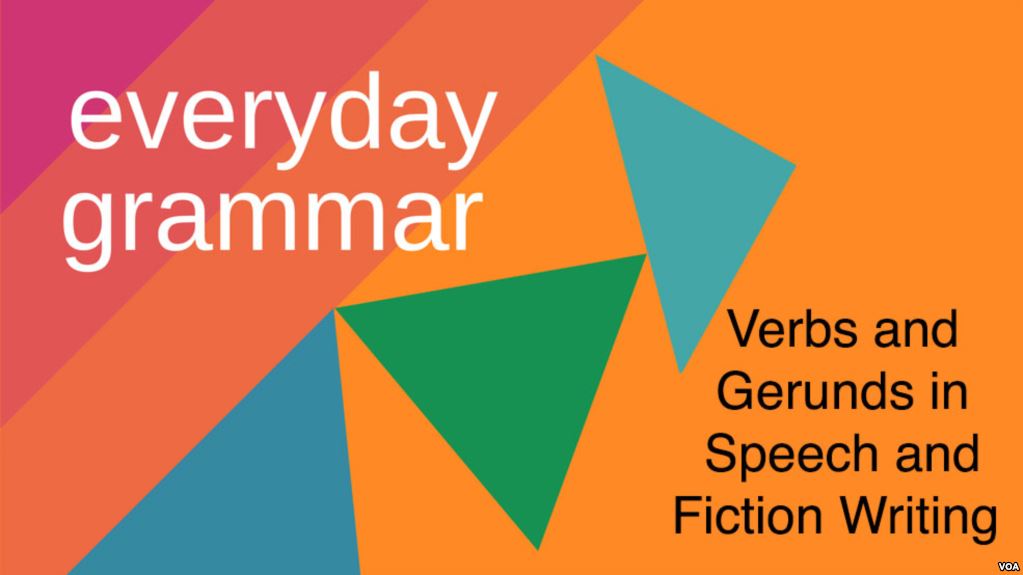
The American rock group Journey released the song “Don’t Stop Believin'” in 1981.
This song, still popular in karaoke music bars, can help you learn about English grammar.
Let’s listen to some words from the song:
Don’t stop believing
Hold on to that feeling
Today, we are going to examine the grammar behind the song’s famous words.
Specifically, we will talk about verb + gerund structures. “Stop believing” is one example of this kind of structure.
Gerunds and Infinitives
Let us begin with a few definitions.
A gerund is the form of a verb that ends with the letters “ing”. Such words act like a noun. For example, in the sentence “I love learning,” the word “learning” is a gerund.
An infinitive is the basic, or simplest form of the verb. Sometimes it has the word “to” in front of it. In the sentence “I like to read books,” the words “to read” are an infinitive.
Some verbs can be followed by an infinitive or a gerund. Knowing when to use an infinitive and when to use a gerund is difficult.
The good news is this: only a few verbs commonly appear with gerunds. Verb + gerund structures are less common than verb + infinitive structures.
When English speakers use verb + gerund structures, the verbs often come from one of three groups.
The groups have meanings that suggest beginnings and ends, thoughts and memories, and sights and sounds.
These three groups are common in everyday speech and fiction writing, but rare in school-related or academic writing.
We will now look closer at each of the groups.
#1 Begin, continue
Here is our first meaning group: beginnings and ends.
Gerunds often follow verbs that suggest a beginning or ending. The most common examples include the verbs begin, start, and stop.
Famous works of American fiction have examples of this structure.
The 1988 novel Tracks, written by Louise Erdrich, begins with the following words:
“We started dying before the snow, and like the snow, we continued to fall.”
In the example, the gerund “dying” follows the verb “started” – a verb that suggests a beginning.
The words from Journey’s song show how speakers use verbs that suggest an ending:
“Don’t stop believing.”
Here, the gerund “believing” follows the verb “stop.”
Now, we will begin exploring our second meaning group.
#2 Remember, think about, think of
The second group is thoughts and memories. Gerunds often follow verbs that suggest that the mind is at work. The most common examples include the verbs remember, think about, and think of.
Consider this example:
“Do you remember playing at that park when we were young?”
In the example, the gerund “playing” follows the verb “remember” – a verb that suggests the mind is working.
Let’s consider another example. Imagine you see a car that has been severely damaged. The owner might say:
“Well, maybe I should think about buying a new car.”
Here, the gerund “buying” follows the verb structure “think about.” Think about means to consider something. It suggests that a person will examine different possibilities and make a decision.
Perhaps we should think about exploring one more meaning group…
#3 Hear, see
Our final meaning group is this: senses. Gerunds often follow verbs that suggest sights and sounds. Common examples include the structures see + a noun phrase + a gerund and hear + a noun phrase + a gerund.
A noun phrase is a group of words that acts like a noun in a sentence.
William Faulkner’s The Sound and the Fury gives you one example of these grammatical structures.
“Through the fence, between the curling flower spaces, I could see them hitting.”
Here, the verb “see” is followed by a pronoun: the word “them”. The gerund, “hitting”, comes after the pronoun.
Here is another example. Imagine you are reading a crime novel and you see the following words:
“He could see a large man waiting in the alley.”
Here, the noun phrase “a large man” comes between the verb “see” and the gerund “waiting.”
What can you do?
The next time you are reading fiction in English or speaking to an American, try to find examples of verb + a gerund. Ask yourself why the speaker may have used the gerund instead of the infinitive. Does the verb relate to one of the groups we talked about today?
Gerunds can be hard to master. It takes time to become skilled in their use. But the most important thing is that you do not stop trying to use them.
I’m Jill Robbins.
And I’m John Russell.
John Russell wrote this story for VOA Learning English. George Grow was the editor.
We want to hear from you. Write to us in the Comments Section.
_______________________________________________________________
Words in This Story
grammar – n. the set of rules that explain how words are used in a language
karaoke bar – n. a place of business where a device plays the music of popular songs and people sing the words to the songs they choose
specifically – adv. used to show the exact purpose or use of something
curling – adj. twisted or formed into a round or curved shape
novel – n. a written work, often long and complex, that deals human experiences
fiction – n. stories about people and events that are not real
